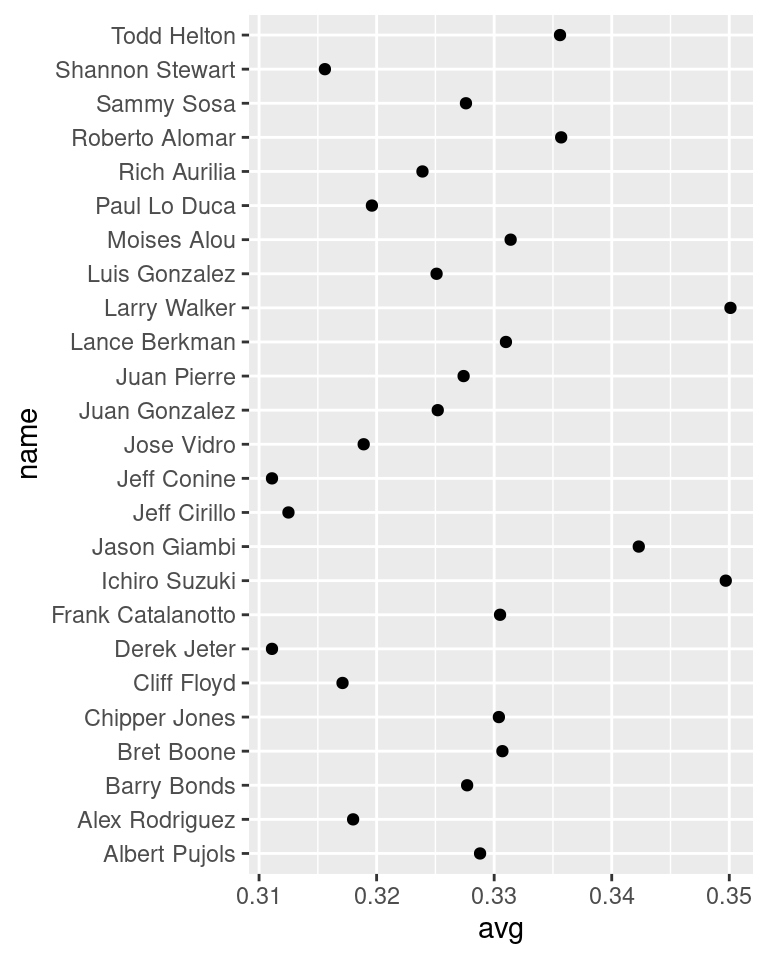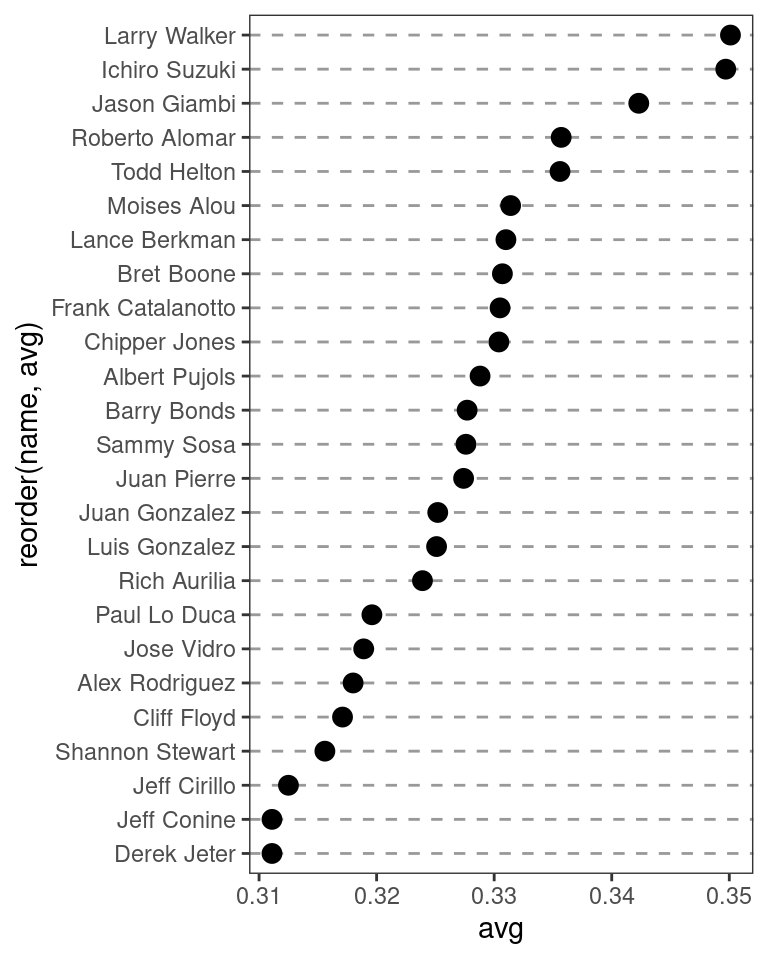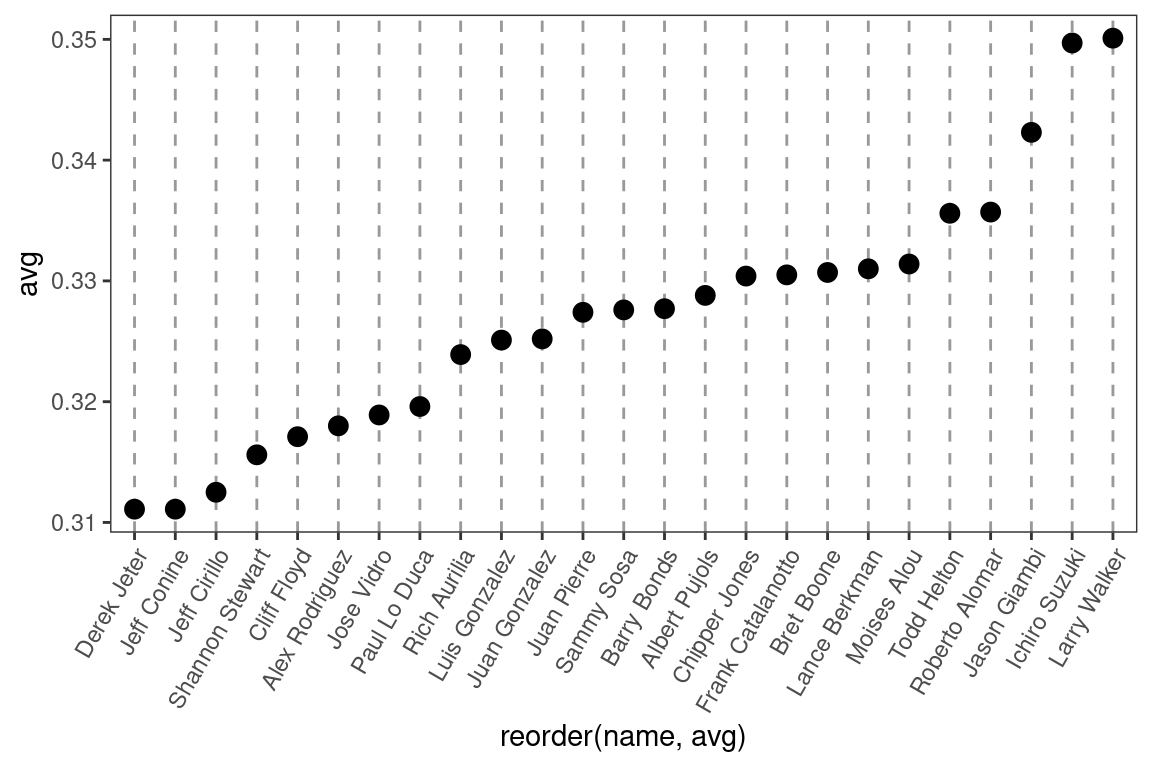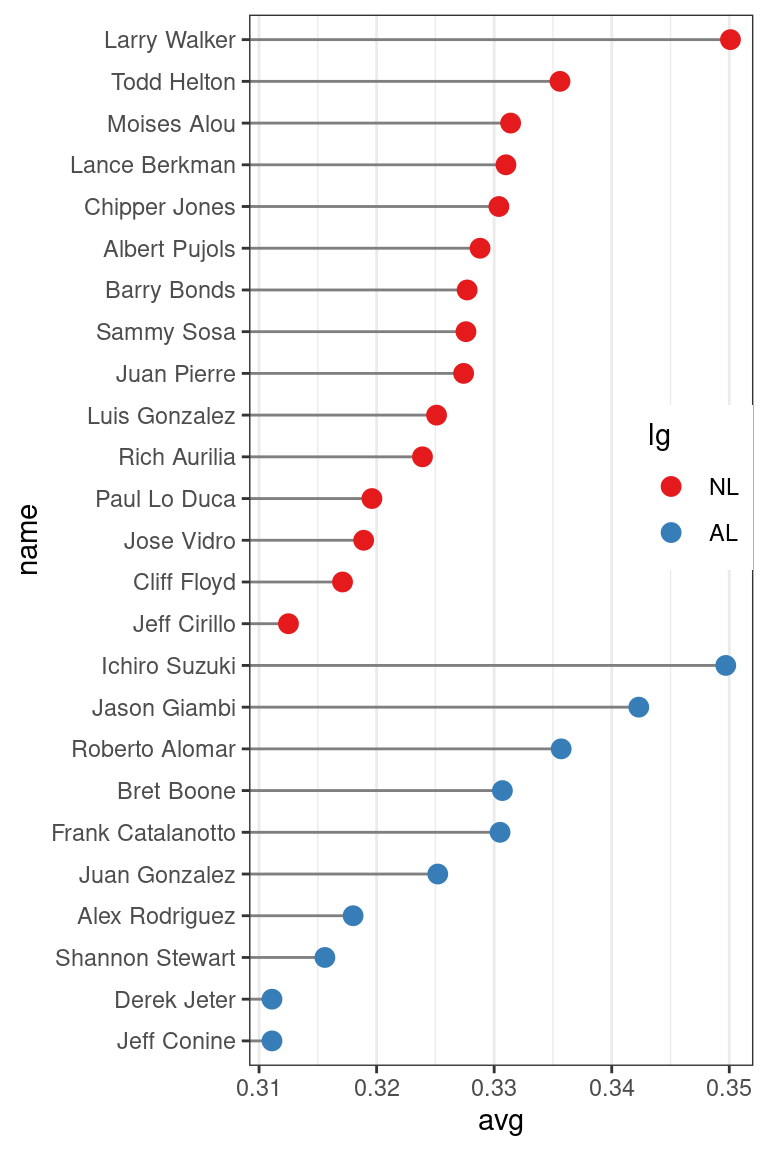3.10 Making a Cleveland Dot Plot
3.10.2 Solution
Cleveland dot plots are an alternative to bar graphs that reduce visual clutter and can be easier to read.
The simplest way to create a dot plot (as shown in Figure 3.28) is to use geom_point():
library(gcookbook) # Load gcookbook for the tophitters2001 data set
tophit <- tophitters2001[1:25, ] # Take the top 25 from the tophitters data set
ggplot(tophit, aes(x = avg, y = name)) +
geom_point()
Figure 3.28: Basic dot plot
3.10.3 Discussion
The tophitters2001 data set contains many columns, but we’ll focus on just three of them for this example:
tophit[, c("name", "lg", "avg")]
#> name lg avg
#> 1 Larry Walker NL 0.3501
#> 2 Ichiro Suzuki AL 0.3497
#> 3 Jason Giambi AL 0.3423
#> ...<19 more rows>...
#> 23 Jeff Cirillo NL 0.3125
#> 24 Jeff Conine AL 0.3111
#> 25 Derek Jeter AL 0.3111In Figure 3.28 the names are sorted alphabetically, which isn’t very useful in this graph. Dot plots are often sorted by the value of the continuous variable on the horizontal axis.
Although the rows of tophit happen to be sorted by avg, that doesn’t mean that the items will be ordered that way in the graph. By default, the items on the given axis will be ordered however is appropriate for the data type. name is a character vector, so it’s ordered alphabetically. If it were a factor, it would use the order defined in the factor levels. In this case, we want name to be sorted by a different variable, avg.
To do this, we can use reorder(name, avg), which takes the name column, turns it into a factor, and sorts the factor levels by avg. To further improve the appearance, we’ll make the vertical grid lines go away by using the theming system, and turn the horizontal grid lines into dashed lines (Figure 3.29):
ggplot(tophit, aes(x = avg, y = reorder(name, avg))) +
geom_point(size = 3) + # Use a larger dot
theme_bw() +
theme(
panel.grid.major.x = element_blank(),
panel.grid.minor.x = element_blank(),
panel.grid.major.y = element_line(colour = "grey60", linetype = "dashed")
)
Figure 3.29: Dot plot, ordered by batting average
It’s also possible to swap the axes so that the names go along the x-axis and the values go along the y-axis, as shown in Figure 3.30. We’ll also rotate the text labels by 60 degrees:
ggplot(tophit, aes(x = reorder(name, avg), y = avg)) +
geom_point(size = 3) + # Use a larger dot
theme_bw() +
theme(
panel.grid.major.y = element_blank(),
panel.grid.minor.y = element_blank(),
panel.grid.major.x = element_line(colour = "grey60", linetype = "dashed"),
axis.text.x = element_text(angle = 60, hjust = 1)
)
Figure 3.30: Dot plot with names on x-axis and values on y-axis
It’s also sometimes desirable to group the items by another variable. In this case we’ll use the factor lg, which has the levels NL and AL, representing the National League and the American League. This time we want to sort first by lg and then by avg. Unfortunately, the reorder() function will only order factor levels by one other variable; to order the factor levels by two variables, we must do it manually:
# Get the names, sorted first by lg, then by avg
nameorder <- tophit$name[order(tophit$lg, tophit$avg)]
# Turn name into a factor, with levels in the order of nameorder
tophit$name <- factor(tophit$name, levels = nameorder)To make the graph (Figure 3.31), we’ll also add a mapping of lg to the color of the points. Instead of using grid lines that run all the way across, this time we’ll make the lines go only up to the points, by using geom_segment(). Note that geom_segment() needs values for x, y, xend, and yend:
ggplot(tophit, aes(x = avg, y = name)) +
geom_segment(aes(yend = name), xend = 0, colour = "grey50") +
geom_point(size = 3, aes(colour = lg)) +
scale_colour_brewer(palette = "Set1", limits = c("NL", "AL")) +
theme_bw() +
theme(
panel.grid.major.y = element_blank(), # No horizontal grid lines
legend.position = c(1, 0.55), # Put legend inside plot area
legend.justification = c(1, 0.5)
)
Figure 3.31: Grouped by league, with lines that stop at the point
Another way to separate the two groups is to use facets, as shown in Figure 3.32. The order in which the facets are displayed is different from the sorting order in Figure 3.31; to change the display order, you must change the order of factor levels in the lg variable:
ggplot(tophit, aes(x = avg, y = name)) +
geom_segment(aes(yend = name), xend = 0, colour = "grey50") +
geom_point(size = 3, aes(colour = lg)) +
scale_colour_brewer(palette = "Set1", limits = c("NL", "AL"), guide = FALSE) +
theme_bw() +
theme(panel.grid.major.y = element_blank()) +
facet_grid(lg ~ ., scales = "free_y", space = "free_y")
Figure 3.32: Faceted by league